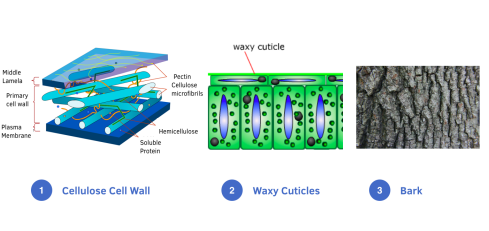
Plants have several defence mechanisms that help them fight off germs. These include physical barriers, such as a waxy cuticle on the leaves that can keep out microbial invaders, as well as chemical defences, such as the production of antimicrobial compounds. Plants also have the ability to recognize and respond to the presence of specific pathogens, triggering a defensive response. Additionally, some plants can produce volatile compounds that signal the presence of disease to other plants and attract beneficial insects that help to defend against pathogens.
Wax covering cuticle
The wax covering the cuticle is known as the cuticle wax. It is a protective wax that is often used in hair care products to protect the hair shaft and scalp from damage and dryness. It helps to lock in moisture and provides a protective barrier against environmental damage. Cuticle wax can also help to reduce frizz and tangles.
Bark
Bark in plants is the protective outer layer of the stem and roots of a tree. It helps to protect the tree from water loss, pests, diseases, and extreme temperatures. Bark also helps to store energy and nutrients for the tree, and provides structural support.
Cell wall
The cell wall is a rigid layer that surrounds the cells of plants, fungi, algae, and some bacteria. It provides structural support and protection, and also acts as a filter that regulates what enters and exits the cell. The cell wall is composed of various polysaccharides and proteins, which can vary depending on the species and the cell type. The outermost layer of the cell wall is composed of a tough, cellulose-rich material known as the primary cell wall, which is further reinforced by a secondary cell wall in many species. The cell wall also contains pores that allow for the passage of water and other molecules.

CUTICLE
